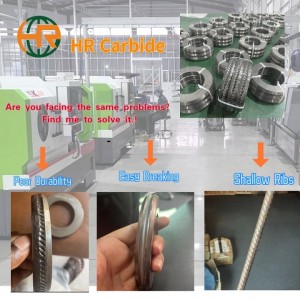Carbide rollers are used in a wide variety of industrial applications, including metal forming, wire drawing, and pipe production. These rollers are known for their exceptional hardness, wear resistance and thermal conductivity, making them ideal for demanding manufacturing processes. However, despite the many advantages of tungsten carbide rolls, certain challenges and issues are not immune to their application. In this article, we will look at some common problems encountered when using carbide rolls and discuss potential solutions to alleviate these problems.
One of the major problems encountered in carbide rolls applications is chipping and cracking. Despite their high hardness, tungsten carbide rolls can still chip and crack, especially when subjected to excessive loads or impacts during rolling. This can lead to premature roll failure and costly downtime on the production line. To address this issue, manufacturers can consider cold rolls optimizing roll designs to minimize stress concentrations, implement proper handling and installation procedures, and use advanced quality control measures to ensure the integrity of the rolls before they are placed into service.
Another common challenge associated with tungsten carbide rolls is thermal cracking. During the rolling process, the rolls are exposed to high temperatures, which can lead to thermal stress and potential cracks. This problem is exacerbated in applications where the roll is subject to rapid temperature changes or uneven heating and cooling. To mitigate thermal cracking, operating parameters such as temperature, speed, and lubrication must be carefully controlled to ensure that the rolls are not exposed to extreme thermal gradients. In addition, the use of advanced thermal barrier coatings and heat-resistant materials helps improve the thermal stability of tungsten carbide rolls in high-temperature applications.
Wear and galling are also significant issues in tungsten carbide rolls applications, especially in metal forming and wire drawing processes where the rolls are in constant contact with the workpiece. Over time, repeated friction and wear can cause material loss and roller surface degradation, affecting finished product quality and requiring frequent roller maintenance and replacement. To address this issue, manufacturers can explore the use of advanced wear-resistant coatings and surface treatments to enhance the wear resistance of carbide rolls. Additionally, optimized lubrication and cooling systems help reduce friction and minimize wear on the roll surfaces.
Additionally, adhesion and material pickup can present challenges in tungsten carbide roller applications, especially when processing sticky or sticky materials. Material buildup on the surface of the roll can cause surface defects in the finished product and require frequent cleaning and maintenance of the roll. To mitigate sticking and material pickup, it is critical to select the appropriate grade of tungsten carbide with customized surface properties to minimize sticking tendencies. Additionally, optimizing process parameters such as temperature, pressure and material hot forging rolls composition can help reduce the likelihood of material pickup on the roll surface.
In summary, while tungsten carbide rolls provide excellent performance and durability in a variety of industrial applications, they are not without challenges. Chipping, cracking, thermal stability, wear and adhesion are common problems encountered in carbide roll applications. By implementing proactive measures such as optimizing roll design, controlling operating parameters, utilizing advanced coatings and surface treatments, and selecting the appropriate grade of tungsten carbide, manufacturers can effectively mitigate these issues and maximize the performance of tungsten carbide rolls in their respective applications. and service life. Continued research and development in the fields of materials science and engineering will further help overcome these challenges and improve the capabilities of tungsten carbide rolls in the manufacturing industry.
Post time: Aug-23-2024










